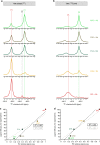Conformational plasticity of ligand-bound and ternary GPCR complexes studied by 19F NMR of the β1-adrenergic receptor
- PMID: 32015348
- PMCID: PMC6997182
- DOI: 10.1038/s41467-020-14526-3
Conformational plasticity of ligand-bound and ternary GPCR complexes studied by 19F NMR of the β1-adrenergic receptor
Abstract
G-protein-coupled receptors (GPCRs) are allosteric signaling proteins that transmit an extracellular stimulus across the cell membrane. Using 19F NMR and site-specific labelling, we investigate the response of the cytoplasmic region of transmembrane helices 6 and 7 of the β1-adrenergic receptor to agonist stimulation and coupling to a Gs-protein-mimetic nanobody. Agonist binding shows the receptor in equilibrium between two inactive states and a pre-active form, increasingly populated with higher ligand efficacy. Nanobody coupling leads to a fully active ternary receptor complex present in amounts correlating directly with agonist efficacy, consistent with partial agonism. While for different agonists the helix 6 environment in the active-state ternary complexes resides in a well-defined conformation, showing little conformational mobility, the environment of the highly conserved NPxxY motif on helix 7 remains dynamic adopting diverse, agonist-specific conformations, implying a further role of this region in receptor function. An inactive nanobody-coupled ternary receptor form is also observed.
Conflict of interest statement
The authors declare no competing interests.
Figures





Similar articles
-
A high-resolution description of β1-adrenergic receptor functional dynamics and allosteric coupling from backbone NMR.Nat Commun. 2020 May 5;11(1):2216. doi: 10.1038/s41467-020-15864-y. Nat Commun. 2020. PMID: 32371991 Free PMC article.
-
High Pressure Shifts the β1-Adrenergic Receptor to the Active Conformation in the Absence of G Protein.J Am Chem Soc. 2019 Oct 23;141(42):16663-16670. doi: 10.1021/jacs.9b06042. Epub 2019 Oct 11. J Am Chem Soc. 2019. PMID: 31564099
-
Backbone NMR reveals allosteric signal transduction networks in the β1-adrenergic receptor.Nature. 2016 Feb 11;530(7589):237-41. doi: 10.1038/nature16577. Epub 2016 Feb 3. Nature. 2016. PMID: 26840483
-
Structure-function of the G protein-coupled receptor superfamily.Annu Rev Pharmacol Toxicol. 2013;53:531-56. doi: 10.1146/annurev-pharmtox-032112-135923. Epub 2012 Nov 8. Annu Rev Pharmacol Toxicol. 2013. PMID: 23140243 Free PMC article. Review.
-
Structural features of β2 adrenergic receptor: crystal structures and beyond.Mol Cells. 2015;38(2):105-11. doi: 10.14348/molcells.2015.2301. Epub 2014 Dec 24. Mol Cells. 2015. PMID: 25537861 Free PMC article. Review.
Cited by
-
Recognition of the ligand-induced spatiotemporal residue pair pattern of β2-adrenergic receptors using 3-D residual networks trained by the time series of protein distance maps.Comput Struct Biotechnol J. 2022 Oct 28;20:6360-6374. doi: 10.1016/j.csbj.2022.10.036. eCollection 2022. Comput Struct Biotechnol J. 2022. PMID: 36420156 Free PMC article.
-
Structural and dynamic insights into supra-physiological activation and allosteric modulation of a muscarinic acetylcholine receptor.Nat Commun. 2023 Jan 23;14(1):376. doi: 10.1038/s41467-022-35726-z. Nat Commun. 2023. PMID: 36690613 Free PMC article.
-
The Impact of the Secondary Binding Pocket on the Pharmacology of Class A GPCRs.Front Pharmacol. 2022 Mar 9;13:847788. doi: 10.3389/fphar.2022.847788. eCollection 2022. Front Pharmacol. 2022. PMID: 35355719 Free PMC article. Review.
-
In Search of Synergistic Insect Repellents: Modeling of Muscarinic GPCR Interactions with Classical and Bitopic Photoactive Ligands.Molecules. 2022 May 20;27(10):3280. doi: 10.3390/molecules27103280. Molecules. 2022. PMID: 35630759 Free PMC article.
-
19F NMR viewed through two different lenses: ligand-observed and protein-observed 19F NMR applications for fragment-based drug discovery.RSC Chem Biol. 2021 Jul 12;2(5):1312-1330. doi: 10.1039/d1cb00085c. eCollection 2021 Oct 7. RSC Chem Biol. 2021. PMID: 34704040 Free PMC article. Review.
References
Publication types
MeSH terms
Substances
Grants and funding
LinkOut - more resources
Full Text Sources

